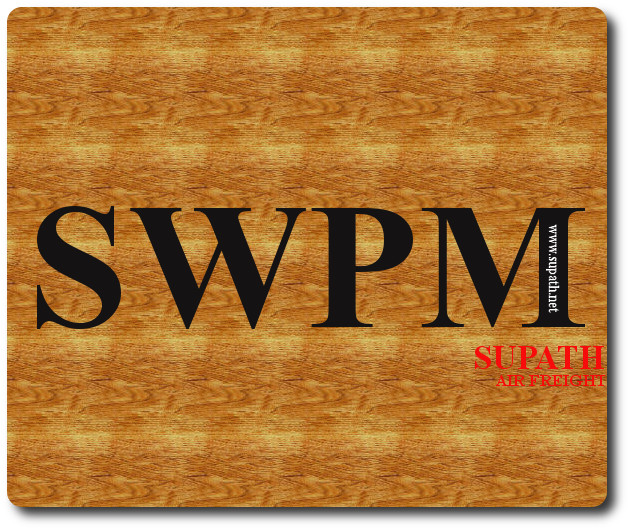Solid Wood Packaging Material in Air Freight – SWPM

Solid Wood Packaging Material – Air Freight Packaging Requirements Include Environmental Care
Solid wood packaging material requirements in air freight is nothing new and it will continue to play a major role in logistics. Transport and environment are inseparably connected and ISPM 15 has become the international standard. As packaging is a part of transport, the materials used for packaging goods are governed by internationally applicable regulations.
Wood and wood based products have been and are still being used widely in packaging, for not only land based transport but also for moving goods by air and by sea. Irrespective of the mode of transport, environmental protection is a part of freight forwarding. Solid wood packing is the relevant theme here I shall try to present as much information as possible. I shall be grateful to the reader for any additional information.
The regulation that is internationally recognised and applicable for solid wood packing material is the ISPM 15. The full document can be downloaded here. The current adopted versions of ISPMs are available for download on www.ippc.int.
Definition According to the US Law – Wood Packaging Material
I am keeping to the official definition of the term wood packaging material, as defined in the e-CFR:
Wood or wood products (excluding paper products) used in supporting, protecting or carrying a commodity (including dunnage).
Wood chips: wood fragments broken or shredded from any wood
Approved WPM Alternatives : Wood Packing Material or SWPM or WPM
Keep to the regulations. Avoid penalties. The importer may be asked to export or destroy (under customs supervision) the non-approved WPM at his own cost. Here is a selection of approved WPM alternatives approved the US government.
- Plywood or press board
- Plastic pallets
- Oriented strand board
- Parallel strand lumber
- synthetic foam
- Metal frames
- Inflated dunnage
- Masonite veneer
WPM Regulations in the US
Arm yourself with information and be up to date when it comes to laws and regulations. The e-CFR (Electronic Code of Federal Regulations) lists the points that refer to wood packaging products. Refer to Title 7 Subtitle B Chapter III Part 319 Subpart 1 . Here is the link to this part of the e-CFR.
ISPM 15 – Background And Relevance
The GATT (General Agreement on Tariffs and Trade) round of 1995, negotiated in Uruguay, an international treaty of the WTO (World Trade Organisation). The treaty named “Agreement on the Application of Sanitary and Phytosanitary Measures” (SPS in short) came into force in 1995.
As per the point International Standards, Guidelines, Recommendations, under 2.2.1 Annex A , International Plant Protection Convention (IPPC) is the organisation that sets the benchmark for phytosanitary measures.
Air freight packaging requirements include not only safety of the content but also environmental regulations. This is especially the case when using solid wood packaging. Here is a list of items that items that fall under the category of WPM :
- Packing cases (inner and outer casings included)
- Boxes
- Crates
- Drums
- Pallets
- Pallet collars or similar items of wood
- Dunnage
Safety – The First Priority in Packaging
The very first priority in packaging is safety of the content. The packaging should be strong and stable enough to protect the content from damage resulting from various factors as mentioned below.
Factors that can cause damage
- Shock (lateral or vertical)
- Vibration
- Bumps, tumbling etc. from rough and fast ground handling
- Moisture, humidity, rain
- Rupture (forklift etc.)
- Temperature fluctuation for items that are temperature sensitive
The Choice – Solid Wood Packaging
When it comes to solid wood packaging material, the safest way to decide is to keep to the official definitions and regulations. The regulations under ISPM 15 are applicable to
- Softwood (coniferous)
- Hardwood (non-coniferous)
Definition of Wood Packaging Material
Three technical acronyms are commonly in use, when referring to solid wood packaging materials. They all refer to the same category.
- WPM : Wood Packaging Materials
- NWPM : Non-Manufactured Wood Packaging Material
- SWPM : Solid Wood Packaging Material
Solid Wood Packaging Material is hardwood or softwood packaging other than that composed wholly of wood-based products such as plywood, particle board, oriented strand board, veneer, wood wool, etc., which has been created using glue, heat and pressure or a combination thereof used in supporting, protecting or carrying a commodity (including dunnage)
At times, the packaging material might carry a bit of bark. Do not ignore this. ISPM 15 has regulations for such cases.
Bark Tolerance In Solid Wood Packaging Materials
The standard outlined in the regulation sets forth solid wood packaging materials free of bark. However, there is room for a bit of flexibility.
Irrespective of the length of the bark, the width of the same may not exceed 3 cm. However, the individual area occupied by the bark may not exceed 50 square cm.
Solid Wood Packaging Materials Must Undergo Treatment : Legal Norms
Wood packaging materials that have undergone heat treatments during manufacture are exempt from treatment. However, recycled or repaired materials must undergo treatment again and the treatment facility must renew the IPPC seal on the product.
The codes of the two methods used for treatments are :
- HT (Heat Treatment)
- MB (Methyl Bromide)
After the necessary treatment, the certified company embosses the IPPC seal along with the treatment code on the material.
The treatments do not have an expiry date. However, as mentioned above the materials need to undergo one of the treatments, if they are recycled or repaired. In such a case obliterate the earlier marking and apply new ones.
The Identification Mark As Evidence of Treatment
Treated wood packaging materials must carry the mark visibility. The mark consists of the following elements
- The IPPC approved symbol
- The ISO code of the country (two letter identification
- The identification number of the facility
- The agency trademark
- The treatment code HT or MB, whichever is applicable
One may use only legally approved markings. A company cannot design its own marking.
The Treatment Mark Regulations
There are regulations attached to the treatment mark. The rules are laid down in Annex 2 of ISPM 15.
The mark must be
- legible
- durable and not transferable
- placed in a location, which is visible, when the solid wood packaging material is in use.
- placed, preferable, on at least two opposite sides and fully visible
The regulations also discourage the use of red or orange colour for the marking. These colours are used for marking goods falling under the dangerous goods regulations
The Exceptions in the USA
The following are some of the exceptions in the US. Courtesy U.S. Customs and Border Protection, CBP Information Centre
- Wood Packaging Material made entirely from wood of Canadian origin, which is exempt from the treatment and marking requirements
- Manufactured items of wood, for example fibreboard, plywood, wine/whiskey barrels, veneer etc.
- By-products from the sawing of wood, such as sawdust, wood-wool, shavings. All of them less than 6 mm in all dimensions
- Wood packaging materials used for most shipments of the department of defence. This can be from those imported by the department itself or by the contractors in the service of the department of defence
For more information please visit the CBP information centre website.
Exceptions as per ISPM 15
The general exceptions as per ISPM 15 are listed in section 2.1 of ISPM.
Some exceptions to this general rule include termites and certain dry wood borers (e.g. Lyctidae).
Packaging For International Air Freight
The safest way is to keep to treated wood for all exports. Using certified wood packaging materials will save processing time in transport at airports.
The other solution is to use materials that do not need certification. Plastic packaging materials are exempt from certification and treatment. However, plastic is a known pollutant and is harmful for the environment. It is wise to avoid plastic packaging materials.
Plywood and particle boards are exempt from certification. However, try to source these materials from manufactures that do not use chlorofluorocarbons in manufacture.
Paper based pallets are available. They can be used be used for a large variety of goods. These packaging materials should be disposable using the usual eco-friendly methods.
Floor Load Tolerance Limitation
An important point to keep in mind when using wood packaging materials is the floor board tolerance limitation. A detailed article on this point can be found here.
Safety – Wobbly content
Avoid wobbly content! The content should be firmly packaged. This will prevent the content from moving during transport. Moving content will transfer the movement to the consignment as a whole, causing a situation where the packaging can sustain damage and cause damage to other pieces in its proximity.
Hygiene – Avoid Damp and Moisture
Wood can absorb moisture and can lead to mould. Moisture can also lead to wood losing its inherent strength. A weak outer packaging is a potential risk to the content. Hence, use check for moist or damp wood, when using wood packaging materials. Using waterproof wrapping for the contents will add to protection and any moisture absorbed by the wood will not seep into the inside, affecting the contents.
Weather Conditions
Weather conditions in both the country of export and in the country of import, including the transit points are to be noted.
Insufficient packaging might lead to obvious damage, when the consignment is in a country having a spell of heavy rains (monsoon). Coniferous wood can easily absorb moisture from the ambient humidity and lose strength. This will make the contents vulnerable.
Risks Arising From Not Following The Regulations For Solid Wood Packaging Materials
We need to protect the environment in which we live. That should be the primary principle we follow even in business life. Freight forwarding is a line of business, goods and hence the packaging materials move on an international level.
Using solid WPM causes risk of transporting pests . Follow the regulations and protect the environment
Preventing the spread of pests is the aim of ISPM 15. However, in view of possible violations of the rules, governments set up regulations under ISPM 20 as a deterrent. The full document may be downloaded from the website of the Food And Agriculture Organisation of the United States.
The country of import will have its own regulations to handle solid wood packaging materials that have not undergone treatment (or materials that do not appear to have undergone treatment ) . The importing countries can apply one or more of the following actions:
- Re-export of the goods at the expense of the shipper
- Treatment , sorting or re-conditioning
- Disinfection of regulated articles (including equipment, premises, storage areas and means of transportation)
- Destruction of the solid wood packaging materials
Conclusion
- Avoid untreated solid wood packaging materials.
- Check your packaging materials for the correct markings.
- Avoid wobbly content.
- Source your packaging materials from certified manufacturers.
- When using WPM (Wooden Packaging Materials) use IPPC certified products
- The IPPC logo must be visible .
- Be up to date with information.
